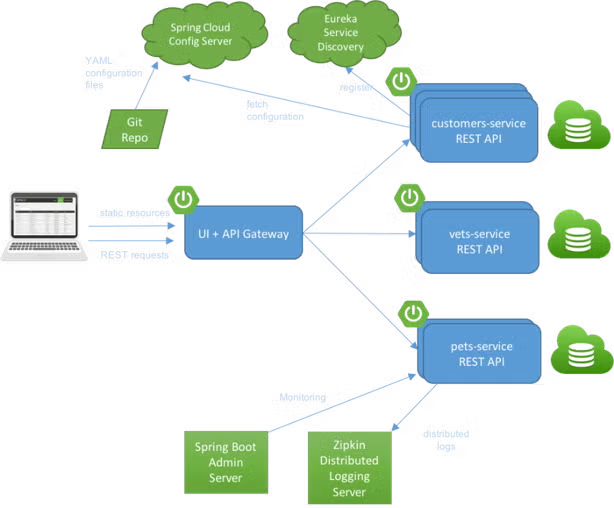Blog
August 26, 2025
Spring Boot is one of the most popular web frameworks used by Java developers. In this blog, we give an overview of Spring Boot, its benefits, and compare it against Spring MVC and Micronaut. Let's get started with a basic overview.
Spring Boot Overview
What Is Spring Boot?
Spring Boot is an open source, microservice-based Java web framework. The Spring Boot framework creates a fully production-ready environment that is completely configurable using its prebuilt code within its codebase. The microservice architecture provides developers with a fully enclosed application, including embedded application servers.
Spring Boot is just extension of the already existing and expansive Spring frameworks, but it has some specific features that make the application easier for working within the developer ecosystem. That extension includes pre-configurable web starter kits that help facilitate the responsibilities of an application server that are required for other Spring projects.
Spring Boot Benefits
Spring Boot has a number of features that make it a great fit for quickly developing Java applications, including auto-configuration, health checks, and opinionated dependencies.
| Feature | Benefit |
|---|---|
| Standalone Application | Can simply build the application jar and run the application with no need to customize the deployment. |
| Embedded Servers | Comes with prebuilt Tomcat, Jetty and Undertow application servers that do not require further installation to use. This also provides faster more efficient deployments resulting to shorter restart times. |
| Auto-Configurable | Spring and other 3rd party frameworks will be configured automatically. |
| Production-Like Features | Health checks, metrics and externalized configurations. |
| Starter Dependencies | This will provide opinionated dependencies designed to simplify the build configuration. This also provides complete build tool flexibility (Maven and Gradle). |
How Popular Is Spring Boot?
How many developers are using Spring Boot? Find out in the latest Java Developer Productivity Report.
How Does Spring Boot Work?
Some may be asking yourselves how does Spring Boot have auto configurations and what does that really mean? It really comes down to three simple Spring Boot annotations that provide this feature:
- @SpringBootApplication
- @EnableAutoConfiguration
- @ComponentScan
Between each one of these annotations Spring Boot is able to provide default project dependencies as well as allow for defaults to overwritten.
@SpringBootApplication
@SpringBootApplication is used in the entry point of the application by adding to the class it resides in needs to have to the application main method. The annotation is needed and will provide each of the other two annotations to your Spring Boot application since the @SpringBootApplication includes both inside.
@EnableAutoConfiguration
The @EnableAutoConfiguration does just that it provides each of the representing classes with the Automatic Configuration capability.
@ComponentScan
Lastly the @ComponentScan will at initialization scan all the beans and package declarations.
Spring Starter Dependencies
Not only does Spring Boot include annotations but it also uses Spring Starter Dependencies to ensure that your application starts with the correct dependencies and so you can hit the ground running so to speak.
Many times, as an application grows larger it can be hard to properly configure project dependencies, the Spring Boot Starter plugins will help facilitate the dependency management. An example of a spring starter dependencies is the Spring Boot Starter web dependency.
That can be used so that your application can have Rest Endpoints written into your application. Overall, they help streamline the development of these applications so that a team will start from a more complex point so less holes will be presented especially with larger applications.
Is Spring Boot Free?
Back to topThe short answer is yes -- Spring Boot is free! However, most development teams will dedicate some funds to supporting Spring Boot, or migrate to fully-supported services like WebSphere and JBoss.
Support for Spring Boot
While Spring Boot is an community-backed open source project from the Spring ecosystem, enterprise Java teams often require additional support to avoid downtime. Third parties including Perforce OpenLogic offer commercial-grade technical support, backed by Service Level Agreements (SLAs), to organizations using Spring-based applications.
Back to topOpenLogic customers receive direct access to Java and Spring experts and get 24/7/365 assistance with Spring Boot, Spring Framework, and related technologies like Tomcat and OpenJDK.
Thinking of upgrading to a newer version of Spring? OpenLogic also provides guidance for Java teams migrating to newer versions of Spring to ensure applications remain secure and performant.
When to Use Spring Boot
Spring Boot should be used anytime microservices are involved and you are planning to use Spring as your primary application framework.
Spring Boot easily promotes the use of Microservice architecture because of it auto configuration, embedded servers and simplified dependency management. Spring Boot helps development teams to create services quickly and efficiently because there is little time spent with initial set up and downloading the appropriate application servers or packages. To coin Pivotal, developers can ‘just run’ the application.
Learn more about Java Microservices
Spring Boot Example
If you really want to get a good understanding and get your hands dirty with an example of a distributed Spring Boot application with many microservices, I would suggest using the Spring-Petclinic-Microservices project.
This project includes an application with 7 microservices, customers and vets and visits services, a new GenAI service based on OpenAI, an API gateway, and some supporting services (Config and Discovery Server). This will provide an out of the box Java web application that is ready to deploy and test with no configurations necessary. Not only does this project provide ready deployments from your IDE but will also provide Docker-ready deployments with few steps needed to follow.

The above example can really highlight why a team would look to implement something like Spring Boot for their application design. There is little no configuration need to deploy, with no server need and can be deployed quickly and efficiently. Hence, why in our recent Java developer survey we found that about 83% of correspondents used the Spring Boot as a Runtime platform. Spring Boot is just paramount to a development team who wants to spend their time developing rather than constantly configuring and setting up.
Back to topSpring Boot vs. Spring MVC
Before getting into the difference between Spring MVC and Spring Boot first let’s talk about what Spring MVC really is and how is it used.
What Is Spring MVC?
Spring MVC is a web-based framework that provides a 3-tier architecture system called the Model-View-Controller. The design of this architecture is to loosely couple each responsibility of the application logic.
The Model component handles the application data, while the View component handles the presentation layer that facilitates the application requests and presents the application response, and the Controller handles the incoming requests, creates proper models, and returns the appropriate request to the View. Spring MVC is and was used to create HTTP oriented web-based applications with lots of different configurations and environments.
What's the Difference Between Spring Boot and Spring MVC?
The major differences between Spring Boot and Spring MVC come down to differences between context and overall scale.
Spring MVC is a specific Spring-based web framework in a traditional sense. That means it requires manual build configurations, specifying dependencies separately, and the use an application server.
Spring Boot, on the other hand, is more like a module of Spring designed to package Spring applications or frameworks with automation and defaults.
So in theory one could have a Spring MVC project packaged as a Spring Boot application. Both can be classified as Spring frameworks however the scale of Spring Boot encompasses many types of Spring frameworks. While, Spring MVC on the other hand specifies the design of the framework.
Back to topSpring Boot vs. Micronaut
Micronaut is a JVM-based framework for building lightweight, modular applications. Like Spring Boot, Micronaut was designed to support the microservice architecture allowing development team to design the quickly and easily.
| Spring Boot Benefits | Micronaut Benefits |
|---|---|
| Application configurations flexibility | Compile time dependency injection |
| Application monitoring | Support for cloud-native applications |
| Auto-Configurable | Spring and other 3rd party frameworks will be configured automatically. |
| Caching providers | First class support for reactive programming |
At this point, I would conclude that Spring Boot still has the advantage to Micronaut. That might simply be due to the fact that Spring Boot has been in the market so much longer and that it is a part of the Spring ecosystem. No matter the case if you were to choose either, each would provide benefits in their own right just in my opinion Spring Boot has better ones.
Back to topFinal Thoughts
By today’s Java development strategies most development teams are either in, about to in or designing to be in a microservice architecture (80% based on our survey). For that fact, and because Spring Boot has well designed major features to support and leverage a microservice architecture, Spring Boot has become such a major part of the enterprise Java ecosystem and is showing no major signs of decline.
Additional Resources
Looking for further reading on Java frameworks, Spring, or curious about how JRebel can help with Spring Boot development? These resources are a great place to start.
- What to Expect in Spring Boot 3
- Best Java Frameworks of 2020
- Spring Annotations Cheat Sheet
- How to Install JRebel for Spring Boot
- How JRebel Can Help Improve Spring Boot Development
Save Time During Spring Boot Development
Want to see how JRebel can streamline your Spring Boot development? Start skipping redeploys today with a JRebel trial or fix performance issues faster with XRebel.
